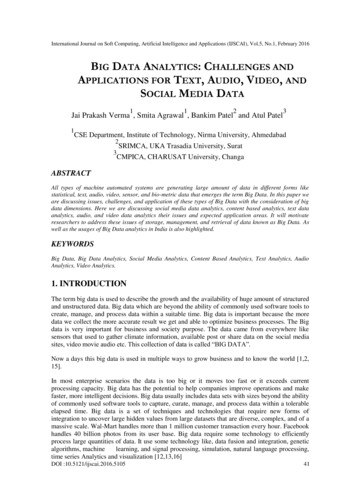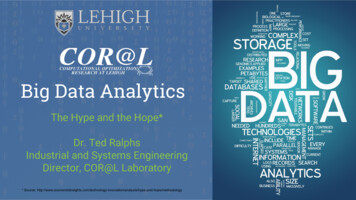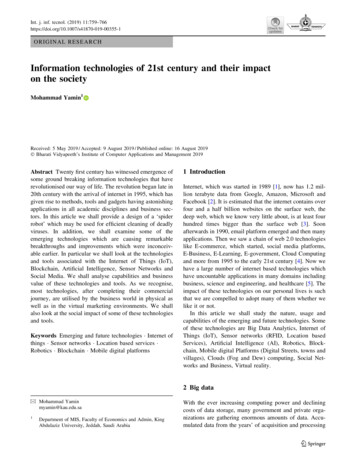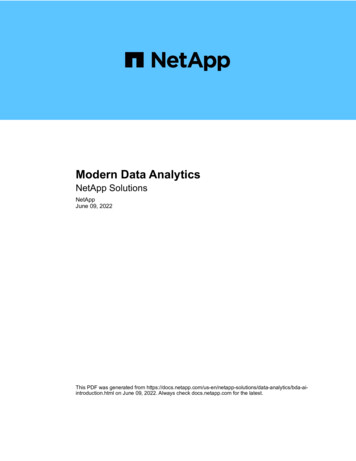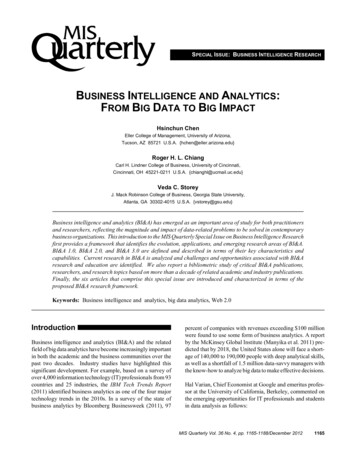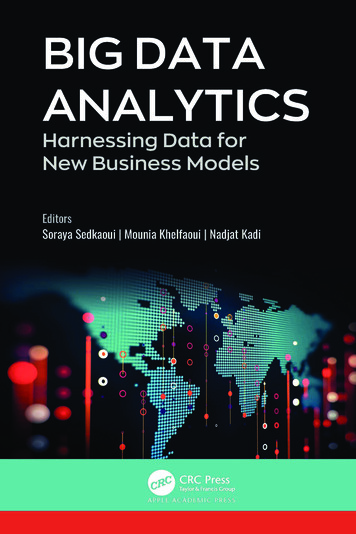
Transcription
BIG DATA ANALYTICSHarnessing Data for New Business Models
BIG DATA ANALYTICSHarnessing Data for New Business ModelsEdited bySoraya Sedkaoui, PhDMounia Khelfaoui, PhDNadjat Kadi, PhD
First edition published 2022Apple Academic Press Inc.1265 Goldenrod Circle, NE,Palm Bay, FL 32905 USA4164 Lakeshore Road, Burlington,ON, L7L 1A4 CanadaCRC Press6000 Broken Sound Parkway NW,Suite 300, Boca Raton, FL 33487-2742 USA2 Park Square, Milton Park,Abingdon, Oxon, OX14 4RN UK 2022 Apple Academic Press, Inc.Apple Academic Press exclusively co-publishes with CRC Press, an imprint of Taylor & Francis Group, LLCReasonable efforts have been made to publish reliable data and information, but the authors, editors, and publisher cannot assumeresponsibility for the validity of all materials or the consequences of their use. The authors, editors, and publishers have attemptedto trace the copyright holders of all material reproduced in this publication and apologize to copyright holders if permission topublish in this form has not been obtained. If any copyright material has not been acknowledged, please write and let us know sowe may rectify in any future reprint.Except as permitted under U.S. Copyright Law, no part of this book may be reprinted, reproduced, transmitted, or utilized in anyform by any electronic, mechanical, or other means, now known or hereafter invented, including photocopying, microfilming, andrecording, or in any information storage or retrieval system, without written permission from the publishers.For permission to photocopy or use material electronically from this work, access www.copyright.com or contact the CopyrightClearance Center, Inc. (CCC), 222 Rosewood Drive, Danvers, MA 01923, 978-750-8400. For works that are not available on CCCplease contact mpkbookspermissions@tandf.co.ukTrademark notice: Product or corporate names may be trademarks or registered trademarks and are used only for identificationand explanation without intent to infringe.Library and Archives Canada Cataloguing in PublicationTitle: Big data analytics : harnessing data for new business models / edited by Soraya Sedkaoui, PhD, Mounia Khelfaoui,PhD, Nadjat Kadi, PhD.Names: Sedkaoui, Soraya, editor. Khelfaoui, Mounia, editor. Kadi, Nadjat, editor.Description: First edition. Includes bibliographical references and index.Identifiers: Canadiana (print) 20210000074 Canadiana (ebook) 2021009009X ISBN 9781771889568 (hardcover) ISBN 9781003129660 (ebook)Subjects: LCSH: Management—Data processing. LCSH: Industrial management—Decision making. LCSH: Businessplanning—Statistical methods. LCSH: Sustainable development. LCSH: Big data.Classification: LCC HD30.2 .B54 2021 DDC 658.4/038—dc23Library of Congress Cataloging-in-Publication DataNames: Sedkaoui, Soraya, editor. Khelfaoui, Mounia, editor. Kadi, Nadjat, editor.Title: Big data analytics : harnessing data for new business models / edited by Soraya Sedkaoui, PhD, Mounia Khelfaoui,PhD, Nadjat Kadi, PhD.Description: First edition. Palm Bay, FL : Apple Academic Press, 2021. Includes bibliographical references and index.Subjects: LCSH: Business--Data processing. Business--Technological innovations. Sustainable development--Dataprocessing. Big data.Classification: LCC HF5548.2 .B4625 2021 (print) LCC HF5548.2 (ebook) DDC 658/.0557--dc23LC record available at https://lccn.loc.gov/2020055946LC ebook record available at https://lccn.loc.gov/2020055947ISBN: 978-1-77188-956-8 (hbk)ISBN: 978-1-77463-786-9 (pbk)ISBN: 978-1-00312-966-0 (ebk)
About the EditorsSoraya Sedkaoui, PhD, HDRSenior Lecturer, University Djilali Bounaama, Khemis-Miliana,Algeria; Data Analyst and Strategic Business Consultant,SRY Consulting Montpellier, FranceSoraya Sedkaoui, PhD, is a Senior Lecturer, Data Analyst, and StrategicBusiness Consultant with more than 10 years of teaching, training, research,and consulting experience in statistics, big data analytics, and machinelearning algorithms. Leading the Big Data Analytic Consulting Practice atSRY Consulting in Montpellier, France, Dr. Soraya is focused on workingwith global clients across industries to determine how a data-driven approachcan be embedded into strategic initiatives. This also includes helpingbusinesses create actionable insights to drive business outcomes that leadto benefits valued in several fields. Dr. Soraya’s works have contributedto delivering analytics services and solutions for competitive advantagethrough the use of algorithms, advanced analytical tools, and data sciencetechniques. She worked as a researcher at TRIS Laboratory at the Universityof Montpellier, France (2011–2017). She contributed to the European projecton “Internet Economics: Methods, Models, and Management (2017)” incollaboration with Pr. H-W Gottinger (STRATEC, Munich, Germany). Shealso contributed to creating many algorithms for business applications, suchas the algorithm of Snail 2016, in France and more. Her science-orientedresearch experience and interests are in the areas of big data, computerscience, and the development of algorithms and models for businessapplications and problems. Dr. Sedkaoui’s prior books and research havebeen published in several refereed editions and journals. Dr. Soraya alsoholds a PhD in economic analysis and an HDR in economic and appliedstatistics.
viAbout the EditorsMounia Khelfaoui, PhD, HDRTeacher-Researcher and Lecturer, University Djilali BounaamaKhemis-Miliana, AlgeriaMounia Khelfaoui, PhD, is a teacher-researcher and Lecturer at the UniversityDjilali Bounaama Khemis-Miliana in Algeria. With experience in research,she is a member of the research laboratory “Industry, Organizational Development of Enterprises and Innovation” of the University of Khemis-Milianasince 2008. Her research focuses on sustainable development, especiallycorporate social responsibility (CSR), the sharing economy, and the circulareconomy. She has published in various journals and conferences dealingwith the topic of CSR and sustainable development. Dr. Khelfaoui’s researchproposes to demonstrate the role of the adoption of the CSR in organizations in light of the principles of sustainable development. She graduatedfrom the University of Algiers 3 with a PhD in economics and an HDR inenvironmental economics.Nadjat Kadi, PhD, HDRSenior Lecturer, University of Djilali Bounaama Khemis-Miliana,Algeria; Manager, The Digital Economy LaboratoryNadjat Kadi, PhD, is a Senior Lecturer at the University of Djilali BounaamaKhemis-Miliana, Algeria. She is the Manager of The Digital Economy Laboratory. Her research relates to economic and statistical analysis and the fieldof demography. She graduated from the University of Oran, Algeria, with aPhD in demography and an HDR in economic and demographic analysis.
ContentsContributors. xiAbbreviations .xvPreface .xviiAcknowledgments.xixPART I: BIG DATA: OPPORTUNITIES AND CHALLENGES. 11.Big Data: An Overview. 3Malika Bakdi and Wassila Chadli2.Big Data between Pros and Cons. 15Djamila Cylia Kheyar3.Big Data Uses and the Challenges They Face. 25Nadia Soudani and Djamila Sadek4.Twitter’s Big Data Analysis Using RStudio . 33Houssame Eddine Balouli and Lazhar Chine5.Big Data for Business Growth in Small andMedium Enterprises (SMEs) . 43Rabia Ahmed BenyahiaPART II: BIG DATA AND BUSINESSES’ DECISION-MAKINGPROCESSES? . 556.The Role of Big Data in Strategic Decision-Making . 57Amal Bensautra, Amel Fassouli, and Fella Ghida7.Data Mining and Its Contribution to Decision-Making inBusiness Organizations. 67Nadia Hamdi Pacha, Fatma Zohra Khebazi, Nachida Mazouz8.The Strategic Role of Big Data Analytics in theDecision-Making Process. 81Yahia Benyahia and Fatima Zohra Hennane9.The Role of the Information System in Making Strategic Decisions inthe Economic Institution: Case Study of Baticic in Ain Defla, Algeria . 93Khedidja Belhadji and Abdellah Kelleche
viiiContents10. The Role of Big Data Analysis and Strategic Vigilance inDecision-Making . 107Bakhta Bettahar and Abdellah Aggoun11. Big Data Analysis and Its Role in Making Strategic Decisions. 121Ramdhan Sahnoun and Boulanouar MokhtariPART III: BIG DATA APPLICATIONS: BUSINESS EXAMPLES. 13112. The Farthest Planning of Big Data in the Light ofInformation Technology: “Smart Cities: A World Not Yet” . 133Noureddine Zahoufi and Abdelkader Dahman13. Blockchain Technology as a Method Based on Organizing Big Datato Build Smart Cities: The Dubai Experience . 145Saliha Hafifi and Fethia Benhadj Djilali Magraoua14. The Uses of Big Data in the Health Sector. 159Fatima Mana, Redouane Ensaad, and Djazia Hassini15. The Role of Big Data in Avoiding the Banking Default in Algeria(The Possibility of Upgrading the Preventive Centers of the Bankof Algeria as a Source of Big Data). 173Mohamed Ilifi and Hamza Belghalem16. Marketing Information System as a Marketing Crisis ManagementMechanism Through Big Data Analytics: A Case Study of AlgeriaTelecom in Bouira . 187Rabah Ghazi and Fatima Zohra Soukeur17. Perspectives of Big Data Analytics’ Integration in theBusiness Strategy of Amazon, Inc. 201Mustapha Bouakel and Amina Zerbout18. The Hospital Information System: A Fundamental Lever forPerformance in Hospitals . 221Zineb Matene and Khalida Mohammed BelkebirPART IV: BIG DATA AND SUSTAINABLE DEVELOPMENT . 23319. Big Data Analysis and Sustainable Development. 235Dehbia El Djouzi20. Big Data for Sustainable Development Goals: Theoretical Approach .247Fatima Lalmi and Rafika Benaichouba21. Using Big Data in Official Statistics for Sustainable Development . 261Khadra Rachedi and Fatima Rachedi
Contentsix22. The Initiatives of the UN to Improve the Quality of Big Data andSupport the Sustainable Development Goals for 2030 . 271Zahia Kouache and Nadia Messaoudi23. Big Data and Its Role in Achieving the Sustainable DevelopmentGoals: Experiences of Leading Organizations . 281Kamel Maiouf and Achour MezrigIndex . 297
ContributorsAbdellah AggounAssistant Professor, Faculty of Economics, Business, and Management Sciences, University of DjilaliBounaama, Khemis Miliana, Algeria, Rue Thniet El Had, Khemis Miliana, Ain Defla, Algeria,E-mail: agg88abd@gmail.comMalika BakdiSenior Researcher, National High School of Statistics and Applied Economics (ENSSEA), Koléa,Algeria, E-mail: bakdi malika@yahoo.frHoussame Eddine BalouliNational High School of Statistics and Applied Economics (ENSSEA), Koléa, Algeria,E-mail: balouli.houssame.eddine@gmail.comHamza BelghalemTemporary Assistant Professor, Faculty of Economics, Business, and Management Sciences,University of Djilali Bounaama, Khemis Miliana, Algeria, E-mail: hamzabelghalem44@gmail.comKhedidja BelhadjiPhD student, Specialization in Production Management, Hassiba Benbouali University, Chlef, Algeria,E-mail: nafoula80@gmail.comKhalida Mohammed BelkebirHDR, Senior Lecturer, and Researcher, Faculty of Business Economics and Management,Djillali Bounaama University, Theniet El Had Street, Khemis Miliana, W. Ain-Defla, Algeria,E-mail: k.mohammed-belkebir@univ-dbkm.dzRafika BenaichoubaPhD in Economic Sciences, Senior Lecturer, University of Djillali Bounaama, Khemis Maliana,Algeria, E-mail: benaichoubarafika@yahoo.frAmal BensautraPhD Student, Faculty of Economics, Business, and Management Sciences, University of DjilaliBounaama, Khemis Miliana, Algeria, E-mail: bensautra.amal@hotmail.comRabia Ahmed BenyahiaUniversity of Djilali Bounaama, Khemis Miliana, Algeria, E-mail: rabiebenyahia33@yahoo.comBakhta BettaharUniversity of Abdelhamid Ibn Badis, Mostaganem, Algeria, E-mail: bakhta 48@hotmail.frMustapha BouakelAssociate Professor, Faculty of Economics, Commerce, and Management Sciences,University Center Ahmed Zabana, Relizane, Algeria, E-mail: mustapha.bouakel@univ-sba.dzWassila ChadliNational High School of Statistics and Applied Economics (ENSSEA), Koléa, AlgeriaE-mail: chadli.wassila@outlook.comLazhar ChineAssociate Professor, Boumerdes University, Algeria, E-mail: l.chine@univ-boumerdes.dz
xiiContributorsAbdelkader DahmanAssistant Professor, Faculty of Economics, Business, and Management Sciences,University of Djilali Bounaama, Khemis Miliana, Algeria, E-mail: abd19dah@gmail.comDehbia El DjouziSenior Lecturer and Researcher, Faculty of Business Economics and Management,Djillali Bounaama University, Theniet El Had Street, Khemis Miliana, Algeria,E-mail: raison81@yahoo.frRedouane EnsaadDepartment of Commercial Sciences, University of Hassiba Ben Bouali, Chlef, Algeria,Pb. 02000, AlgeriaAmel FassouliPhD Student, Faculty of Economics, Business, and Management Sciences,University of Djilali Bounaama, Khemis Miliana, Algeria, E-mail: Amelsabrine2018@gmail.comRabah GhaziLaboratory of Globalization, Politics, and Economics, University of Algiers 3, Dely Brahim, Algeria,E-mail: ghazi.rabah@univ-alger3.dzFella GhidaSenior Lecturer, and Researcher, Faculty of Economics, Business, and Management Sciences,University of Djilali Bounaama, Khemis Miliana, Algeria, E-mail: fghida@yahoo.frSaliha HafifiSenior Lecturer, Faculty of Economics, Business, and Management Sciences,University of Djilali Bounaama, Khemis Miliana, Algeria, E-mail: hafifis18@yahoo.frDjazia HassiniDepartment of Economic Sciences, University of Hassiba Ben Bouali, Chlef, AlgeriaFatima Zohra HennanePhD Student, University Ali Lounici-Blida 2, Route d’El Afroun, Blida, Algeria,E-mail: Hennane fz@yahoo.frMohamed IlifiSenior Lecturer, Faculty of Economics, Business, and Management Sciences,University of Djilali Bounaama, Khemis Miliana, Algeria, E-mail: m.ilifi@univ-dbkm.dzAbdellah KellecheSenior Lecturer, Hassiba Benbouali University, Chlef, Algeria, Pb. 02000, Algeria,E-mail: kabd.dz@gmail.comFatma Zohra KhebaziLecturer, Faculty of Economics, Business, and Management Sciences, Khemis Miliana University,Rue Thiniet El Had, Khemis Miliana, Ain Defla, Algeria, E-mail: fkhebazi@gmail.comDjamila Cylia KheyarPhD Student, Faculty of Economics, Business, and Management Sciences,University of Djilali Bounaama, Khemis Miliana, Algeria, E-mail: kheyar.djamilacylia@gmail.comZahia KouacheSenior Lecturer, Faculty of Economics, Business, and Management Sciences,University of Djilali Bounaama, Khemis Miliana, Algeria, E-mail: z.kouache@univ-dbkm.dzFatima LalmiPhD in Economic Sciences, Senior Lecturer, University of Abdelhamid Ibn Badis, Mostaganem,Algeria, E-mail: lalmi.fatima@yahoo.fr
ContributorsxiiiFethia Benhadj Djilali MagraouaSenior Lecturer, Faculty of Economics, Business, and Management Sciences,University of Djilali Bounaama, Khemis Miliana, Algeria, E-mail: magr fati@yahoo.frKamel MaioufDepartment of Sciences Economy, Commercial, and Management Sciences,Hassiba Ben Bouali University of Chlef, Pb. 02000, Algeria, E-mail: m.kamel@univ-chlef.dzFatima ManaSenior Lecturer, Department of Management Sciences, University of Hassiba Ben Bouali,Chlef, Algeria, E-mail: f.mana@univ-chlef.dzZineb MateneAssistant Professor and Researcher, Faculty of Business Economics and Management,Djillali Bounaama University, Theniet El Had Street, Khemis Miliana, W. Ain-Defla, Algeria,E-mail: z.matene@univ-dbkm.dzNachida MazouzLecturer, Faculty of Economics, Business, and Management Sciences, University Ali Lounici-Blida 2,Route d’El Afroun, Blida, AlgeriaNadia MessaoudiAssistant Professor, Faculty of Economics, Business, and Management Sciences,University of Djilali Bounaama, Khemis Miliana, Algeria, E-mail: n.messaoudi@univ-dbkm.dzAchour MezrigDepartment of Sciences Economy, Commercial, and Management Sciences,Hassiba Ben Bouali University of Chlef, Pb. 02000, Algeria, E-mail: m.kamel@univ-chlef.dzBoulanouar MokhtariSenior Lecturer, Faculty of Economics, Business, and Management Sciences,University of Djilali Bounaama, Khemis Miliana, Algeria, E-mail: b.mokhtari@univ-dbkm.dzNadia Hamdi PachaLecturer and Researcher, Faculty of Economics, Business, and Management Sciences,University Ali Lounici-Blida 2, Route d’El Afroun, Blida, Algeria,E-mail: hamdipacha.n@hotmail.comFatima RachediUniversity of Larbi Ben Mhidi, Oum El Bouagui, Algeria, E-mail: rachedi.fatima@yahoo.frKhadra RachediUniversity of Oran 2, Algeria, E-mail: Kha-dra@hotmail.frDjamila SadekFaculty of Economics, Business, and Management Sciences, University Center of Tissemsilt, Algeria,E-mail: sadek.djamila.ecom@gmail.comRamdhan SahnounPhD Student, Faculty of Economics, Business, and Management Sciences,University of Djilali Bounaama, Khemis Miliana, Algeria, E-mail: laz152.rs@gmail.comFatima Zohra SoukeurLaboratory of Globalization, Politics, and Economics, University of Algiers 3, Dely Brahim, Algeria,E-mail: zola marketing@yahoo.frNadia SoudaniFaculty of Economics, Business, and Management Sciences, University Center of Tissemsilt, Algeria,E-mail: soudani mag@hotmail.com
xivContributorsYahia BenyahiaPhD Student, University Ali Lounici-Blida 2, Route d’El Afroun, Blida, Algeria,E-mail: ey.benyahia@univblida2.dzNoureddine ZahoufiAssistant Professor, Faculty of Economics, Business, and Management Sciences,University of Djilali Bounaama, Khemis Miliana, Algeria, E-mail: zahoufi.norddine@gmail.comAmina ZerboutPhD Student, Faculty of Economics, Commerce, and Management Sciences, University Ali Lounici,Blida 2, Algeria, E-mail: ea.zerbout@univ-blida2.dz
SMEsURLWCEDWHOAssociation for Computing MachineryTechnical Agency for Hospital InformationAmazon web servicesbig databusiness intelligencebulk synchronous parallelCenters for Disease Control and Preventiondefinition of the table in the systemdata miningEducation For Allextraction, transformation, and loadingfocus group on sustainable smart citiesglobal positioning systemHadoop distributed file systemhospital information systeminformation and communication technologiesInternational Data Corporationinternet of thingsInternational Standards Organizationinformation, technology, and communicationsJavaScript object notationlearning modelspayment card industryProgramme de Médicalisation des Systèmesd’Informationresilient distributed datasetsradio-frequency identificationsocial media analyticssmall and medium enterprisesuniform resource languageWorld Commission on Environment and DevelopmentWorld Health Organization
Preface“Where there’s data smoke, there’s business fire.”―Thomas C. RedmanData-Driven: Profiting from Your Most Important Business AssetIn recent years, significant investments have been made in companies’ infrastructure to increase their data collection capacity. Practically, all aspectsof a business are now open to data collection: operations, manufacturing,supply chain management, customer behavior, the performance of marketingcampaigns, flow management procedures, etc.Simultaneously, data about events outside the company, such as markettrends, company news, and competitors’ activities, is now widely available.This data availability has sparked a growing interest in methods of extractinguseful information and knowledge from data: the field of “big data analytics.”Big data and data analytics are being adopted more frequently, especiallyin companies looking for new methods to develop smarter capabilities andtackle challenges in the dynamic processes. The possible uses of big dataanalytics are numerous and cross-sector. With the vast amounts of data available today, companies in every sector are now focusing on harnessing data tocreate a new way of doing business.The current discussion about this field, which is often referred to as revolutionary, can be described using W. Edwards Deming’s description:Data are not taken for museum purposes; they are taken as a basis fordoing something. If nothing is to be done with the data, then there is nouse in collecting any. The ultimate purpose of taking data is to provide abasis for action or a recommendation for action. The step intermediatebetween the collection of data and the action is prediction.In addition, due to big data analytics’ cross-business application scenarios,several specific business concepts are also affected. The analysis, therefore,focuses on both technical and organizational aspects of big data tools andtechnologies.Therefore, the challenges of the current business playground requirea radical change in the manner of exploring the potential associated with
xviiiPrefacedata for creating value, which presents a pillar of business sustainabilitynowadays.In this context, the 4th National Conference on “Big Data Analytics:Harnessing Data for New Business Models” (BDA2019) aimed to providea forum for researchers alike to exchange the latest fundamental advancesin the big data field and its best practices, and as well as emerging researchtopics that would define the future of big data applications in the businesscontext.BDA2019 emerged as an outcome of several research results from Algerian academics to provide relevant lessons learned from specific data usesthat generate value in the business context. During the 1st and 2nd of October2019, at the Faculty of Economics at the University of Khemis Miliana,Algeria, we have celebrated and shared the knowledge on this exciting field.In these two special days, the BDA2019 has provided researchers, academics,and experts an opportunity to exchange and share their research experiencesand results and deepen the debate on data-driven value creation.This conference aimed to work out possible potentials based on a basicintroduction to big data analytics, before the main sections dealt in detail withthe challenges relating to this innovative technology, its diverse applicationsin the business context, how this technology enhances the decision-makingprocess, and how it contributes to achieving the sustainable developmentgoals.But the raised exciting question of BDA2019 was the application of theadvanced tools and technologies of this emerging field and its evidentialvalue within businesses around the world. The question is whether businesses accross the world will adapt to this paradigm or whether the big datacan be integrated into the architecture of global business.This book gathers selected works related to big data applications inseveral areas, focusing on the diverse points discussed during these two business days. Throughout this book’s four parts, we will detail various subjectsand techniques relating to big data analytics and its applications.We hope this book can encourage more engaging research at national andinternational levels on the big data applications in the business context. Wewish you an exciting and stimulating reading and formulate the necessarybases to resolve big data dilemmas in business practice!—Editors
AcknowledgmentsWe are pleased to thank the authors whose submissions and participationmade this conference possible. We also want to express our thanks to theProgram Committee members for their dedication in organizing the conference. Also, we would like to thank Apple Academic Press (AAP) team fortheir help during the editing process of this book, especially Sandra JonesSickels, Ashish Kumar, Sheetal, and Rakesh. Finally, the reviewers fortheir hard work reviewing process, which was essential for the success ofBDA2019 and the publication of this book.—Soraya, Mounia, and NadjatEditors
PART IBig Data: Opportunities and Challenges
CHAPTER 1Big Data: An OverviewMALIKA BAKDI1 and WASSILA CHADLI2Senior Researcher, National High School of Statistics and AppliedEconomics (ENSSEA), Koléa, Algeria, E-mail: bakdi malika@yahoo.fr1National High School of Statistics and Applied Economics (ENSSEA),Koléa, Algeria, E-mail: chadli.wassila@outlook.com2ABSTRACTThis chapter focuses on a new trend to process and analyze large data, i.e.,big data. It has become an imperative approach, particularly with the massiveoutbreak of data on the Internet (videos, photos, messages, social networks,e-commerce transactions, etc.) and the large diffusion use of connectedobjects (smartphones and tablets). In this research, we attempt to representthe big data phenomenon’s designs, architectures, and applications.1.1INTRODUCTIONData and algorithms shape a new world that consists of a form of culminationfor computing and, more precisely, a new way of controlling information.With more than 95% of the world’s data set having been created in recentyears, it is important to know that it is not the one who has the best algorithmwins, but the one who has more data; and it is not just any type of data, butonly the reliable data that are counted. As a result, a large amount of data willbe accumulated as we have algorithms that work very efficiently based onthe data we process.Thus, the major problem with this large amount of data is that itbecomes very difficult to work with, especially with the traditional databaseprocessing tools [4]. Today, companies are facing an exponential increase in
4Big Data Analytics: Harnessing Data for New Business Modelsdata volume. To give us a more precise idea, we can attain several petabytes(10)15, see even zettabytes (10)21.As expected, the amount of data created and managed has grownexponentially over the past few years. Hence, we can imagine how hugethe amount of data that will be created in the future years, as data can beacquired from logs, social media, e-commerce transactions (the data are of adiverse nature), etc. Undoubtedly, many companies want to take advantageof this data – whether data collected by themselves or public data such asthe web or open data. As a result, traditional technologies are not designedto process with a massive data explosion, and therefore thanks to big data,where the exponential growth of data can be processed.In this work, we present theoretical research about big data. It should bementioned that 2012 was the year of the big data buzz when the notion waspopularized; this means that companies are dealing with an amount volumeof data to be processed, which presents a technical and economic challenge.The objective of the present work is to answer the following questions:what is big data? Why are we interested in big data? In addition, what is therevolutionary technology adopted by big data?1.2BIG DATA: CONCEPT AND DEFINITIONCertainly, in the explanation of big data, a lot has been said about the volume,which is one of the very important aspects of the clarification of the bigdata concept. Thus, a classic definition has been proposed by Gartner, whichimplies three dimensions (as shown in Figure 1.1).FIGURE 1.1 The three V’s of big data.Source: Authors’ creation.
Big Data: An Overview5The first one is about volume: it is the massive explosion of data thatrequires their processing and analysis. The second dimension is variety,which corresponds to the difficulty of processing and analyzing data, butmore precisely, crossing the new data sources in an effective way that ismore diverse and from multiple nature. Thus, the variety distinguishes bigdata from traditional data analysis. Indeed, big data analyzes data sets fromdifferent sources [8]. The third dimension is the velocity, which correspondsto the speed with which they are generated, processed, and stored.It is clear that individuals and companies are great data generators in avery short time, but there is a shifted time between their processing and theirgeneration. The coming of big data technology makes the job easier, thusgiving us the advantage of processing data while it is being generated.Subsequently, the explanation of big data does not focus exclusively onthese three dimensions, as IBM has added two other dimensions to properlytarget the explanation, which are veracity and value. Veracity is the abilityto have reliable data; for example, the generation of data by spambot is anexample worthy of confidence. Another example is that of Mexico, wherethe presidential elections were made by a fake Twitter account.The fifth is the value, having an equivalent meaning that the big dataapproach only makes sense to achieve strategic objectives related toindividuals and the company, for the purpose of creating an added value,regardless of the field of activity. Thus, the success of a big data project islargely correlated by the creation of added value a
Big Data: An Overview. 3 . Malika Bakdi and Wassila Chadli 2. Big Data between Pros and Cons. 15 . Djamila Cylia Kheyar 3. Big Data Uses and the Challenges They Face. 25 . Nadia Soudani and Djamila Sadek 4. Twitter's Big Data Analysis Using RStudio . 33 . Houssame Eddine Balouli and Lazhar Chine 5. Big Data for Business Growth in Small and
